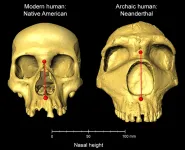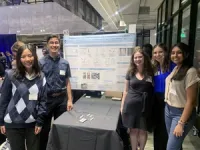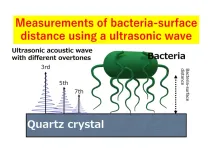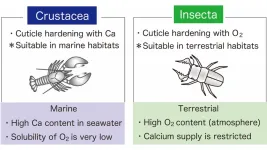(Press-News.org) Humans inherited genetic material from Neanderthals that affects the shape of our noses, finds a new study led by UCL researchers.
The new Communications Biology study finds that a particular gene, which leads to a taller nose (from top to bottom), may have been the product of natural selection as ancient humans adapted to colder climates after leaving Africa.
Co-corresponding author Dr Kaustubh Adhikari (UCL Genetics, Evolution & Environment and The Open University) said: “In the last 15 years, since the Neanderthal genome has been sequenced, we have been able to learn that our own ancestors apparently interbred with Neanderthals, leaving us with little bits of their DNA.
“Here, we find that some DNA inherited from Neanderthals influences the shape of our faces. This could have been helpful to our ancestors, as it has been passed down for thousands of generations.”
The study used data from more than 6,000 volunteers across Latin America, of mixed European, Native American and African ancestry, who are part of the UCL-led CANDELA study, which recruited from Brazil, Colombia, Chile, Mexico and Peru. The researchers compared genetic information from the participants to photographs of their faces – specifically looking at distances between points on their faces, such as the tip of the nose or the edge of the lips – to see how different facial traits were associated with the presence of different genetic markers.
The researchers newly identified 33 genome regions associated with face shape, 26 of which they were able to replicate in comparisons with data from other ethnicities using participants in east Asia, Europe, or Africa.
In one genome region in particular, called ATF3, the researchers found that many people in their study with Native American ancestry (as well as others with east Asian ancestry from another cohort) had genetic material in this gene that was inherited from the Neanderthals, contributing to increased nasal height. They also found that this gene region has signs of natural selection, suggesting that it conferred an advantage for those carrying the genetic material.
First author Dr Qing Li (Fudan University) said: “It has long been speculated that the shape of our noses is determined by natural selection; as our noses can help us to regulate the temperature and humidity of the air we breathe in, different shaped noses may be better suited to different climates that our ancestors lived in. The gene we have identified here may have been inherited from Neanderthals to help humans adapt to colder climates as our ancestors moved out of Africa.”
Co-corresponding author Professor Andres Ruiz-Linares (Fudan University, UCL Genetics, Evolution & Environment, and Aix-Marseille University) added: “Most genetic studies of human diversity have investigated the genes of Europeans; our study’s diverse sample of Latin American participants broadens the reach of genetic study findings, helping us to better understand the genetics of all humans.”
The finding is the second discovery of DNA from archaic humans, distinct from Homo sapiens, affecting our face shape. The same team discovered in a 2021 paper that a gene influencing lip shape was inherited from the ancient Denisovans.*
The study involved researchers based in the UK, China, France, Argentina, Chile, Peru, Colombia, Mexico, Germany, and Brazil.
* UCL News, 2021: Genes for face shape identified
END
Nose shape gene inherited from Neanderthals
2023-05-08
ELSE PRESS RELEASES FROM THIS DATE:
Immunotherapy plus chemotherapy combination for advanced lung cancer not only prolongs life but also improves its quality
2023-05-08
A recent clinical trial showed that the drug combination of cemiplimab plus platinum chemotherapy can prolong survival in patients with advanced lung cancer when compared with placebo plus platinum chemotherapy. Now an analysis published by Wiley online in CANCER, a peer-reviewed journal of the American Cancer Society, indicates that cemiplimab plus platinum chemotherapy also affects quality of life compared to chemotherapy alone.
The multinational phase 3 EMPOWER-Lung 3 trial had shown that the addition ...
Organoids derived from patient tissues support personalized cancer treatment
2023-05-08
Chicago (May 2, 2023) — Researchers created organoids from cancer cells to reduce the need for trial and error in identifying effective cancer treatments in one of many cancer studies scheduled for presentation this week at Digestive Disease Week® (DDW) 2023.
Below are summaries of three studies scheduled for DDW, their embargo times and presentation times at the meeting in Chicago May 6-9.
Personalized drug screening in patient-derived organoids of biliary tract cancer and its clinical application
Chemotherapy is often the only treatment option for biliary tract cancer, which is usually found at a late stage, making it one of the most lethal ...
Cognitive behavioral therapy lessens post-viral fatigue after COVID-19
2023-05-08
Those with post-viral fatigue after suffering from COVID-19 benefit from cognitive behavioural therapy, resulting in less fatigue and concentration problems. Lead researcher, Hans Knoop, Professor of Medical Psychology at Amsterdam UMC found that “After behavioural therapy, patients not only had less symptoms but also functioned better both physically and socially. Those improvements were still present even after six months.” Today, research from Amsterdam UMC, RadboudUMC and three other hospitals is published in Clinical Infectious Diseases.
After a COVID-19 infection, a substantial number of patients report persisting symptoms. This is often known as long-COVID or ...
Examining the adhesion tendency of biofilm-forming bacteria on organic surfaces
2023-05-08
The biofilm-forming bacteria E. coli adheres firmly to hydrophobic and hydrophilic protein-adsorbing self-assembling monolayers (SAMs) and weakly to hydrophilic protein-resisting SAMs, uncovered a recent study by Tokyo Tech researchers. These findings on how surface chemistry can influence the adhesion of bacterial cells and, in turn, biofilm formation could open doors to bacteria-resistant surfaces and antibiofouling coatings for biomedical and industrial devices.
Bacterial biofilms are like a double-edged sword. On one hand, they have proven valuable ...
New decision aid to help with screening to prevent fragility fractures
2023-05-08
Should healthy people be screened to help reduce their risk of fragility fractures? A new interactive online Fragility Fracture Decision Aid for shared decision-making can help clinicians and patients visualize their individual risk of fracture and the potential benefits and harms of preventive treatment.
The decision aid is part of a new guideline https://www.cmaj.ca/lookup/doi/10.1503/cmaj.221219 from the Canadian Task Force on Preventive Health Care on screening to prevent fragility fractures. The guideline, ...
Pediatric IBD risk linked to antibiotics, Western diet and higher family income
2023-05-07
CHICAGO (May 7, 2023) — Children and adolescents face greater risk of inflammatory bowel disease (IBD) when exposed to antibiotics or a Western diet at early ages, or when their family has higher socioeconomic status, according to a study being presented today at Digestive Disease Week® (DDW) 2023.
“Pediatric IBD cases are rising globally, and approximately 1 in 4 of all IBD cases are now diagnosed before age 21,” said Nisha Thacker, the study’s lead author and a gastrointestinal dietitian. A unique concern about pediatric IBD is the impact that the inflammation has on a child’s growth and the progression of puberty, ...
Domestic abuse exposure linked to increased levels of asthma and other atopic diseases
2023-05-06
Women who have suffered domestic abuse may have a higher risk of developing atopic diseases including asthma, new research has found.
Published today in the Journal of Allergy and Clinical Immunology: In Practice, the research led by the University of Birmingham found that in analysis of patient records, there were a significantly larger percentage of women who had atopic diseases and had a history of being exposed to domestic abuse and violence compared to those who hadn’t.
Dr Joht Singh Chandan from the University of Birmingham and corresponding author of the study said:
“After adjusting for possible cofounders, ...
NIH study identifies features of Long COVID neurological symptoms
2023-05-06
What:
Twelve people with persistent neurological symptoms after SARS-CoV-2 infection were intensely studied at the National Institutes of Health (NIH) and were found to have differences in their immune cell profiles and autonomic dysfunction. These data inform future studies to help explain persistent neurological symptoms in Long COVID. The findings, published in Neurology: Neuroimmunology & Neuroinflammation, may lead to better diagnoses and new treatments.
People with post-acute sequelae of COVID-19 (PASC), which includes Long COVID, have a wide range of symptoms, including fatigue, ...
How interleukin-6 helps prevent allergic asthma and atopy by suppressing interleukin-2 signaling
2023-05-06
BIRMINGHAM, Ala. – The immune system has a biological telecommunications system — small proteins known as interleukins that send signals among the leukocyte white blood cells to control their defense against infections or nascent cancer. Interleukin-6, or IL-6, is one of these key mediators of inflammation, and it can, as needed, provoke the immune system into attack against pathogens.
However, imbalances of IL-6 — too much or too little — can cause disease, even in the absence of infection. Excess IL-6 is central to the pathogenesis of inflammatory reactions like ...
Why are there so few insects in the ocean?
2023-05-06
Tokyo, Japan – Scientists from Tokyo Metropolitan University have proposed a hypothesis for why insects are so rare in marine environments. They previously showed that insects evolved a unique chemical mechanism to harden their shells which uses molecular oxygen and an enzyme called multicopper oxidase-2 (MCO2). Now, they argue that this gives them a disadvantage in the sea, while it confers advantages that help them on land, placing MCO2 at the heart of insect eco-evolution.
Insects are some of the most successful organisms on the planet. ...





